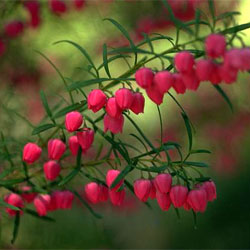Boronia heterophylla
 |
 |
Red or Kalgan Boronia
On seeing the Red or Kalgan Boronia (Boronia heterophylla) in vivid flower everyone may wish to have one, and may wonder if it is easy to obtain and grow. It may be bought from some nurseries dealing in native plants, and its popularity is established in gardens as an easily-grown medium shrub which will live a good number of years with simple care.
Like the Brown Boronia (B. megastigma) it is native to Western Australia, is more robust and has a sweet scent in both leaves and flowers, though less powerful than the better known species. When lingering over the scent a slightly bitter aroma is sometimes noticed recalling Rue, and other plants of this family (Rutaceae) to which Boronias belong.
Growth is dense, flexible and soft in all parts and quite hardy to local winter
conditions. Drought and hot winds, however, are not tolerated, and adequate
water must be given, especially in summer. lt is essential to keep the roots
cool and as watering on bare soil will not do this in extreme heat a mulch must
be used unless nearby plants provide shade. Making sure the ground is soaked
first, several inches of leaf mould or compost should be put around the plant.
Another method is to use sizeable flat rocks. These look attractive, and in
fact a large rockery makes a fine setting for this subject; with its roots protected
it flourishes in full sun.
In habit it is evenly round or oval, quickly making a mature specimen which
may be 1 m high when two years old from planting, and eventually reaching over
1.3 m high. Healthy foliage has a fresh appearance all the year and individual
leaves may vary on one plant from narrow and simple to finely divided.
From the leaf axils the squarish waxy bell flowers hang on short stalks, in clusters of two or three or singly. They appear around the third week of October and are a brilliant magenta pink, an unusual colour among shrubs at this season. On fading they close again to look like pointed buds and turn paler pink and white; this colour holds till around mid-December in a cool spring. They finally fall, and seed has not been found here. Propagation is easy from cuttings, using young stem tips at a half-ripe stage. Plants succeed in any lime-free soil, light or heavy. Pruning is another operation which should be done regularly to keep up bushy growth, and if desired this may be combined with cutting freely for decoration. This is a good time to prune as before flowering is over new growth is starting which would be lost if pruned later. No serious pest or diseases have been noted.
Based on text by Irene Beeton (1971)
Name meaning: Boronia heterophyllaBoronia - after an Italian, F. Borone who accompanied expeditions in the 18th century; heterophylla - variable leaves |
![An Australian Government Initiative [logo]](/images/austgovt_brown_90px.gif)

